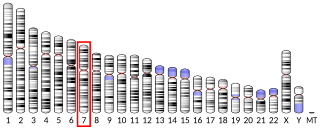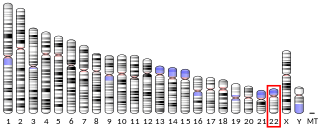
In cell biology, the spindle apparatus is the cytoskeletal structure of eukaryotic cells that forms during cell division to separate sister chromatids between daughter cells. It is referred to as the mitotic spindle during mitosis, a process that produces genetically identical daughter cells, or the meiotic spindle during meiosis, a process that produces gametes with half the number of chromosomes of the parent cell.

Condensins are large protein complexes that play a central role in chromosome assembly and segregation during mitosis and meiosis. Their subunits were originally identified as major components of mitotic chromosomes assembled in Xenopus egg extracts.
SMC complexes represent a large family of ATPases that participate in many aspects of higher-order chromosome organization and dynamics. SMC stands for Structural Maintenance of Chromosomes.

Aurora kinase B is a protein that functions in the attachment of the mitotic spindle to the centromere.

Kinesin-like protein KIF22 is a protein that in humans is encoded by the KIF22 gene.

A-kinase anchor protein 8 is an enzyme that, in humans, is encoded by the AKAP8 gene.

DNA polymerase delta subunit 2 is an enzyme that in humans is encoded by the POLD2 gene. It is a component of the DNA polymerase delta complex.

Anaphase-promoting complex subunit 2 is an enzyme that in humans is encoded by the ANAPC2 gene.

Macrophage-capping protein (CAPG) also known as actin regulatory protein CAP-G is a protein that in humans is encoded by the CAPG gene.

Structural maintenance of chromosomes protein 4 (SMC-4) also known as chromosome-associated polypeptide C (CAP-C) or XCAP-C homolog is a protein that in humans is encoded by the SMC4 gene. SMC-4 is a core subunit of condensin I and II, large protein complexes involved in high order chromosome organization, including condensation and segregation. SMC-4 protein is commonly associated with the SMC-2 protein, another protein complex within the SMC protein family. SMC-4 dimerizes with SMC-2, creating the flexible and dynamic structure of the condensin holocomplex. An over-expression of the SMC-4 protein is shown to impact carcinogenesis.

Katanin p60 ATPase-containing subunit A1 is an enzyme that in humans is encoded by the KATNA1 gene.

Condensin-2 complex subunit D3 (CAP-D3) also known as non-SMC condensin II complex subunit D3 (NCAPD3) is a protein that, in humans, is encoded by the NCAPD3 gene. CAP-D3 is a subunit of condensin II, a large protein complex involved in chromosome condensation.

Condensin complex subunit 2 also known as chromosome-associated protein H (CAP-H) or non-SMC condensin I complex subunit H (NCAPH) is a protein that in humans is encoded by the NCAPH gene. CAP-H is a subunit of condensin I, a large protein complex involved in chromosome condensation. Abnormal expression of NCAPH may be linked to various types of carcinogenesis as a prognostic indicator.

Condensin complex subunit 3 also known as condensin subunit CAP-G (CAP-G) or non-SMC condensin I complex subunit G (NCAPG) is a protein that in humans is encoded by the NCAPG gene. CAP-G is a subunit of condensin I, a large protein complex involved in chromosome condensation.

Sister chromatid cohesion protein PDS5 homolog A is a protein that in humans is encoded by the PDS5A gene.

Condensin-2 complex subunit G2 (CAP-G2) also known as chromosome-associated protein G2 (CAP-G2) or leucine zipper protein 5 (LUZP5) is a protein that in humans is encoded by the NCAPG2 gene. CAP-G2 is a subunit of condensin II, a large protein complex involved in chromosome condensation. It interacts with PLK1 through its C-terminal region during mitosis

Structural maintenance of chromosomes protein 2 (SMC-2), also known as chromosome-associated protein E (CAP-E), is a protein that in humans is encoded by the SMC2 gene. SMC2 is part of the SMC protein family and is a core subunit of condensin I and II, large protein complexes involved in chromosome condensation, overall organization. Several studies have demonstrated the necessity of SMC2 for cell division and proliferation.

Condensin-2 complex subunit H2, also known as chromosome-associated protein H2 (CAP-H2) or non-SMC condensin II complex subunit H2 (NCAPH2), is a protein that in humans is encoded by the NCAPH2 gene. CAP-H2 is a subunit of condensin II, a large protein complex involved in chromosome condensation.

Structural maintenance of chromosomes protein 1B (SMC-1B) is a protein that in humans is encoded by the SMC1B gene. SMC proteins engage in chromosome organization and can be broken into 3 groups based on function which are cohesins, condensins, and DNA repair. SMC-1B belongs to a family of proteins required for chromatid cohesion and DNA recombination during meiosis and mitosis. SMC1B protein appears to participate with other cohesins REC8, STAG3 and SMC3 in sister-chromatid cohesion throughout the whole meiotic process in human oocytes.
In biology, the chromosome scaffold is the backbone that supports the structure of the chromosomes. It is composed of a group of non-histone proteins that are essential in the structure and maintenance of eukaryotic chromosomes throughout the cell cycle. These scaffold proteins are responsible for the condensation of chromatin during mitosis.



















